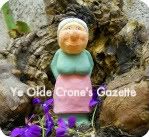I start by making a batch of PMC. I got the recipe from a website called Ultimate Paper Mache. This site belongs to Jonni Good who developed this recipe and posted it to share with the rest of us. This is a fairly inexpensive compound made with paper pulp, joint compound, Elmer’s glue, flour and linseed oil. The hard part is getting all of the ingredients blended together so there are no lumps of paper pulp. This is also one of my least favorite parts of the whole thing. I bought a hand held electric mixer to use for mixing the “dough” and burned out the motor after only four or five batches.
Next step is deciding what I’m going to make. I know it’s going to be a Santa, but I don’t know anything else about it. Sometimes I will get out the old sketch book and try to recreate on paper one of the many ideas that are floating around in my head. I might draw several head shots with different hats. I might draw an idea of the complete figure and include choices for color of hat and cloak etc. Once I have a general idea of what the piece is going to look like I need an armature.
PMC is applied in thin layers over an armature. I don’t like leaving the armature in the piece as I’m afraid it won’t dry thoroughly with it inside, so I need to keep that in mind when making the armature. Once the armature is made I put a plastic grocery bag over the armature and secure it in place. The plastic covered armature is then covered with paper strips that have been coated with flour and water paste. I use a stiff bristled paint brush to smooth the paper strips. I usually apply 2 – 3 layers of strips. Here comes the first wait for it to dry stage. You will note that there are many such periods where I have to wait for it to dry throughout this process.
After the paper strips have dried, the first layer of PMC is applied evenly. Now I’m at the second wait for it to dry stage. What I’ve made so far is what I refer to as a blank.
Once the blank is completely dried and hardened, it needs to be filed and sanded smooth. This is another of my least favorite things to do. PMC dries extremely hard and it takes forever to smooth down the ridges and bumps not to mention all of the dust from filing, grinding and sanding. My sister and I are concerned about the amounts of paper dust that we inhale. We’ve both tried wearing dust masks but found they get in the way of blowing off the dust on the part or drinking from our coffee cup. I’ve tried doing both with a mask on. I’ve also worn the dumb thing around my neck or on the top of my head for the rest of the day.
Now it’s back to filing and sanding and grinding again. More detail is added to the piece and then more drying time. This process is repeated until I decide the piece is finished. Now it has to be completely dried. Once parts are completed I usually leave them in the oven for several hours and then on the heater vent over night. The PMC has to be totally dried before it can be painted.
Now the fun part begins. This is where the piece starts getting interesting. Arms and mittens, collars and hats, hair and beards and all sorts of fun things are modeled onto the blank. Anything that protrudes away from the body has to be supported in some manner, so little armatures that remain in place get added onto the blank. I use rolled up bits of cardboard and wads of paper or pieces of egg carton for these add-ons. Once I’ve added more PMC I’m again at a wait for it to dry stage. I’ve found that I can hurry the drying along by putting the piece into the oven at 190 degrees or sitting it on a drying rack with a space heater facing it. My sister has several floor heater vents she sits her pieces on. I’m not so lucky.
Like every other man, Santa has chores. On this particular day he is going to split logs for the fire place. Since the chopping block is near the stable, he has brought carrots for the reindeer. We all know that Santa is jolly, so of course he is whistling while he does his chores.
When I sketched this piece I had planned on the scarf only being visible from the back, but decided he should tuck his beard inside his cloak and have the scarf tied in front. I’ve wanted to paint something plaid for a while now and thought this would be the perfect time to do it.
I hope this has been helpful in giving you an idea of how I spend nearly every waking moment of my day. Just joking.
Thanks for dropping by.

































3 comments:
Maddy this was a wonderful WIP, thank you for going to the trouble to let us know how you do it. I love this Santa and the sweet expression on his face.
I love this work in progress. It is so interesting to see all the steps that go into your beautiful work! :-)
Thanks for the kind words. I had a bit of a problem getting this one posted. For some reason the spacing between the text and photos was all off, and the text wanted to wrap around two of the photos. Thanks Maggie for helping me get this fixed.
Post a Comment